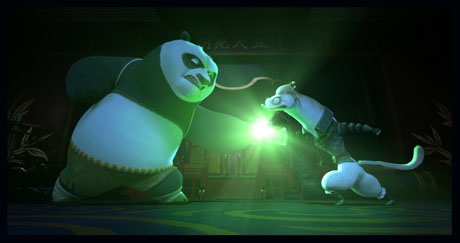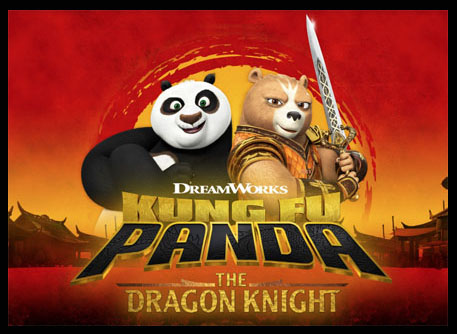
Po the Panda is back! And so is Jack Black. He reprises the role of the beloved DreamWorks character in new animated series Kung Fu Panda: The Dragon Knight, premiering this Thursday July 14th on Netflix. I spoke with executive producers Peter Hastings and Shaunt Nigoghossian about the next chapter in the action and comedy packed saga. (This Animation Scoop Q&A was edited for length and clarity.)
Jackson Murphy: Peter, when and how did it click for you that [you] can continue the iconic Po the Panda story with this new show?
Peter Hastings: It basically comes down to the fact that when you have a really, really strong lead character, you can keep telling stories with them because they have an interesting take. They have a funny take. It’s an opening to do a lot of stuff. James Bond or Austin Powers — and Po is one of those strong personality characters who can just keep telling more and more stories. And coming in with an angle to do something a little different in terms of the story, which is how we ended-up with our set-up for our current series.

JM: Shaunt, how did you want to stay true to this legacy: what’s been built for the last 14 years, while also bringing some new flavor?

Shaunt Nigoghossian
JM: Peter, Jack Black returns as Po the Panda for the first time since Kung Fu Panda 3, which came out in 2016. How was it collaborating with him and figuring out [how to] create an arc for an 11-episode season… as opposed to creating an arc for a 90-minute movie?
PH: He is Po. And he is that guy who wants to play, have fun, do silly voices and who loves the soft and sentimental and sad kind of moments. Being very familiar with Po, it was pretty easy for us to get on track and to start recording. Nothing but positives. And the way that storytelling has changed in TV recently is that there’s much more of an opening to do longer stories. Basically, what happens is: you come-up with important beats you wanna hit along the way, but you don’t know exactly how you’re gonna get there. And so every episode still needs to be figured out. We know we want to get to this big piece of information here. We have that to kind of hang our hat on and then figure the rest out as we go along.

JM: This is a journey / quest series, with some big goals for these characters. Shaunt, how did you want to create the perfect partner for Po in Rita Ora’s Wandering Blade character?
SN: It was about her physicality. Po’s really low and moves and bounces. His animation is actually bouncy. She’s very rigid. She always looks down. She doesn’t move her head that much. I have to constantly make notes about: “Don’t make her smile. She doesn’t smile. We’re saving that smile for the end.” (laughs) She’s gonna get one smile, that’s it! Everything from how she sits to how she eats to how she does everything is all very rigid. Even in how she was designed.
JM: I love the lava tightrope sequence that’s in the second episode.

Peter Hastings
JM: The details are so important, and one of the details I noticed in the first episode is a Tigress toy in Po’s bag. Shaunt, what kind of Easter Eggs are we gonna get throughout the season?
SN: A lot! (laughs) If you’re looking, there are plenty of little Easter Eggs like that going on all through the series. For sure. It’s fun. I sort of can’t even talk about too much stuff, so I’ll leave it there.
JM: One of the themes I got is Po learning to accept responsibility. Peter, how did you want to infuse that theme and some of the other ones into this show?
PH: One of the things that was so appealing and fun in the very first movie is that Po is a loser, and he achieves this status. I kind of felt like maybe he was just getting a little too fancy for his own good. And also because it’s so fun to watch this guy kind of prove himself and want to prove himself. And for anybody in the process of proving yourself, the myth of what it looks like and what other people think of you and what other people call you and then there’s the internal part, which is accepting yourself and taking on that challenge and knowing that a title doesn’t make you are. Just being the truest version of yourself is really what you need to be. He basically starts-out, “I need to get my crown back”, which leads to him joining Wandering Blade on this mission. But along the way the challenge is really about being his best version of himself and accepting the people he’s gotta work with even if they’re different.

JM: You’re right. You start out with Po a little cocky. “I’ve achieved this certain status in my life…” and all of a sudden it kind of hits him in the face, and he has to face reality and win everyone over again.
PH: In the Pilot, there’s a scene where he has to go through a crowd of people and everyone recognizes him and is all over him. And I was like, “Jack, do you have any idea what that’s like?” (laughs) And he’s like, “Oh yeah. It’s happened to me a few times. I’ve been in an airport and people line up.” (laughs) So he was able to tap into that immediately.
JM: And some of the key words in the Kung Fu Panda franchise are “secrets” and “mastering”. So Shaunt, what is the secret to mastering the art of an animated comedy?
SN: Oh my goodness. It’s not one secret. It’s a whole truck load of secrets, actually. For animated comedy, you have to understand timing and how to get a montage working and how to set-up and pay-off a joke. It’s even harder when you’re doing an action show that’s also a comedy show. Action is one type. Comedy is one type. And this show has both of those, plus it has heart, and it’s not finishing up an episode and starting from scratch the next episode. We are doing a serialized story. So that’s the hardest type of show. We’re doing the very hardest type of show that you can do. You have to have all the skills and we had to make sure we got people on the show who come from different parts of animation who can come together and build it this way. It’s tough, but there it is!
PH: But the driver in all of that is being true to the character of Po and recognizing what he’s like. He’s got all the elements that we need. So it’s really about tapping into that. “What Would Po Do?”

JM: And one of the other big themes I got is summoning and finding your inner peace. Peter, how were you able to find your inner peace as you were making these 11 episodes?
PH: I’m just gonna go right back to Po. Are you being true to this storytelling? Are you being true to the tone of this property? That gives you inner peace in terms of making the show. And then as much you can, fixing things when they tap you on the shoulder and say, “That doesn’t feel true. That doesn’t feel authentic.” And taking the time to fix those things when you can — that brings you inner peace in making the show.
JM: And Shaunt, what is the most awesome toy you’ve seen for a show that you’ve been a part of? The Po the Panda toy is a big part of the first episode.
SN: Oh my Good Lord. Hmmm. That’s a good question. It probably was a Transformer. Maybe Bulkhead in Transformers Prime. They made an actual metallic version of it. That might be a winner.
JM: Nice. Peter, you got one?
PH: I have a bag of Animaniacs Happy Meal toys from the ’90s. (laughs)
- INTERVIEW: Strap In For “Mars Express” - April 30, 2024
- INTERVIEW: Jeff Fowler On “Knuckles” And “Sonic 3” - April 22, 2024
- INTERVIEW: “Inside Out 2” Director And Producer On Pixar Sequel - April 16, 2024


 July 11th, 2022
July 11th, 2022  Jackson Murphy
Jackson Murphy  Posted in
Posted in  Tags:
Tags: 






